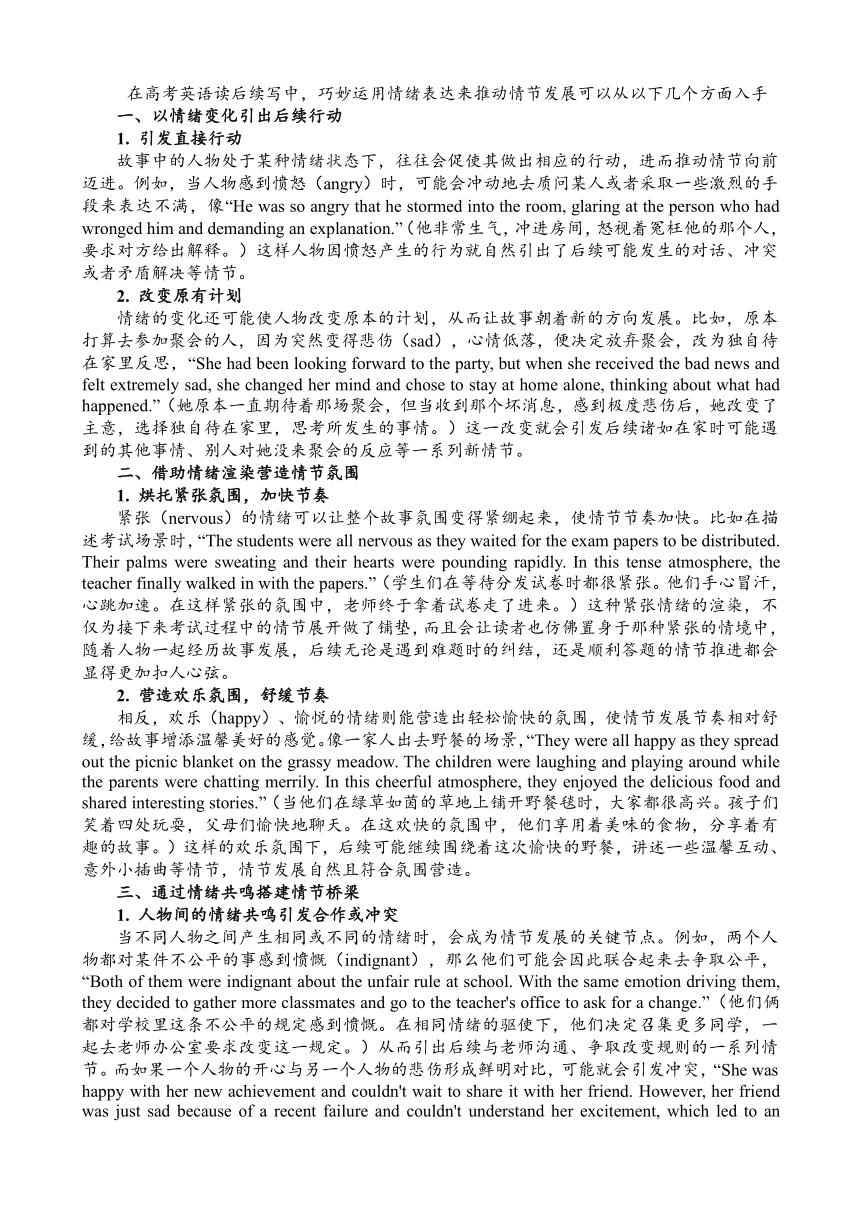
在高考英语读后续写中,巧妙运用情绪表达来推动情节发展可以从以下几个方面入手 一、以情绪变化引出后续行动 1. 引发直接行动 故事中的人物处于某种情绪状态下,往往会促使其做出相应的行动,进而推动情节向前迈进。例如,当人物感到愤怒(angry)时,可能会冲动地去质问某人或者采取一些激烈的手段来表达不满,像“He was so angry that he stormed into the room, glaring at the person who had wronged him and demanding an explanation.”(他非常生气,冲进房间,怒视着冤枉他的那个人,要求对方给出解释。)这样人物因愤怒产生的行为就自然引出了后续可能发生的对话、冲突或者矛盾解决等情节。 2. 改变原有计划 情绪的变化还可能使人物改变原本的计划,从而让故事朝着新的方向发展。比如,原本打算去参加聚会的人,因为突然变得悲伤(sad),心情低落,便决定放弃聚会,改为独自待在家里反思,“She had been looking forward to the party, but when she received the bad news and felt extremely sad, she changed her mind and chose to stay at home alone, thinking about what had happened.”(她原本一直期待着那场聚会,但当收到那个坏消息,感到极度悲伤后,她改变了主意,选择独自待在家里,思考所发生的事情。)这一改变就会引发后续诸如在家时可能遇到的其他事情、别人对她没来聚会的反应等一系列新情节。 二、借助情绪渲染营造情节氛围 1. 烘托紧张氛围,加快节奏 紧张(nervous)的情绪可以让整个故事氛围变得紧绷起来,使情节节奏加快。比如在描述考试场景时,“The students were all nervous as they waited for the exam papers to be distributed. Their palms were sweating and their hearts were pounding rapidly. In this tense atmosphere, the teacher finally walked in with the papers.”(学生们在等待分发试卷时都很紧张。他们手心冒汗,心跳加速。在这样紧张的氛围中,老师终于拿着试卷走了进来。)这种紧张情绪的渲染,不仅为接下来考试过程中的情节展开做了铺垫,而且会让读者也仿佛置身于那种紧张的情境中,随着人物一起经历故事发展,后续无论是遇到难题时的纠结,还是顺利答题的情节推进都会显得更加扣人心弦。 2. 营造欢乐氛围,舒缓节奏 相反,欢乐(happy)、愉悦的情绪则能营造出轻松愉快的氛围,使情节发展节奏相对舒缓,给故事增添温馨美好的感觉。像一家人出去野餐的场景,“They were all happy as they spread out the picnic blanket on the grassy meadow. The children were laughing and playing around while the parents were chatting merrily. In this cheerful atmosphere, they enjoyed the delicious food and shared interesting stories.”(当他们在绿草如茵的草地上铺开野餐毯时,大家都很高兴。孩子们笑着四处玩耍,父母们愉快地聊天。在这欢快的氛围中,他们享用着美味的食物,分享着有趣的故事。)这样的欢乐氛围下,后续可能继续围绕着这次愉快的野餐,讲述一些温馨互动、意外小插曲等情节,情节发展自然且符合氛围营造。 三、通过情绪共鸣搭建情节桥梁 1. 人物间的情绪共鸣引发合作或冲突 当不同人物之间产生相同或不同的情绪时,会成为情节发展的关键节点。例如,两个人物都对某件不公平的事感到愤慨(indignant),那么他们可能会因此联合起来去争取公平,“Both of them were indignant about the unfair rule at school. With the same emotion driving them, they decided to gather more classmates and go to the teacher's office to ask for a change.”(他们俩都对学校里这条不公平的规定感到愤慨。在相同情绪的驱使下,他们决定召集 ... ...
~~ 您好,已阅读到文档的结尾了 ~~